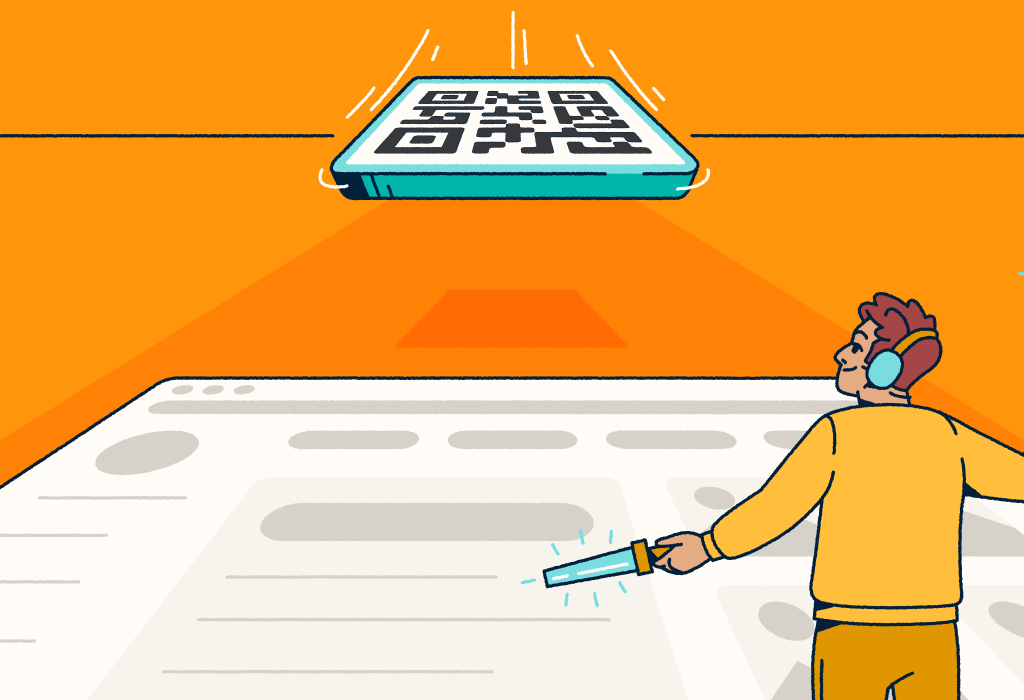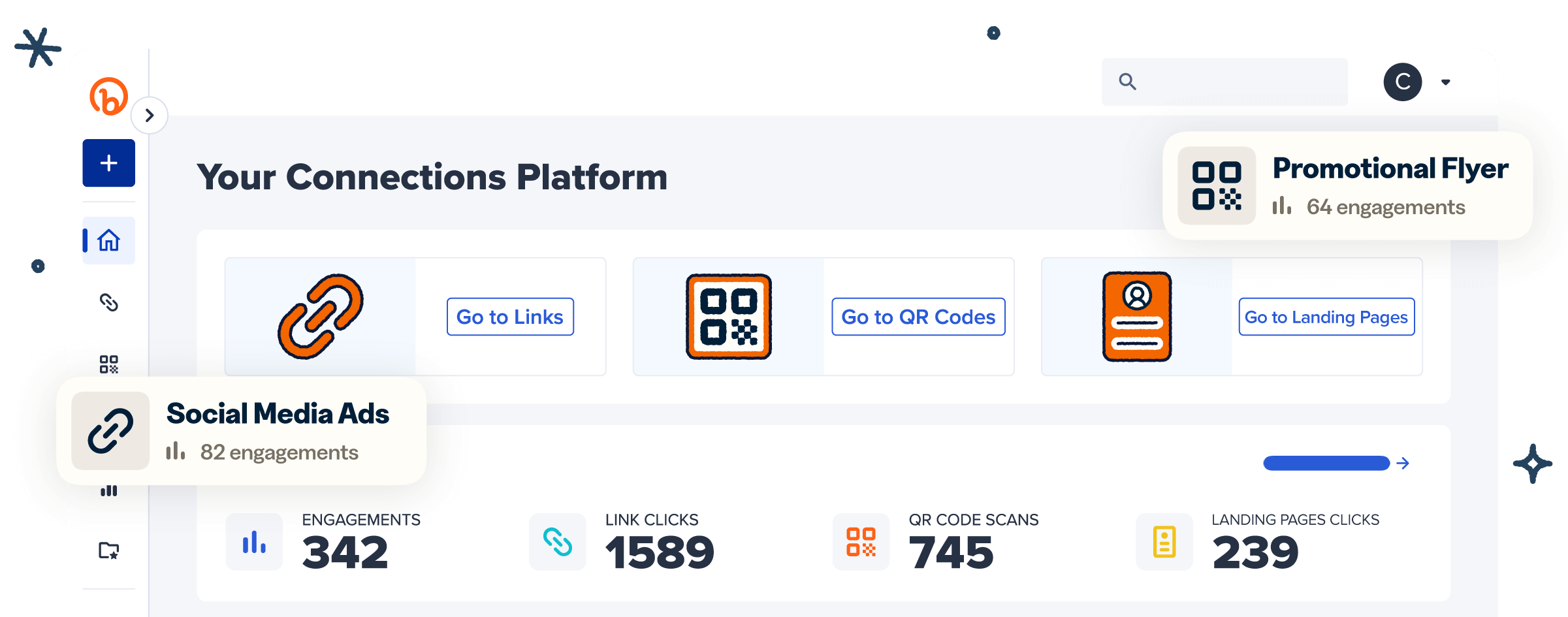What do restaurant menus, billboards, and TV ads have in common? They’re all ideal spots for brands to place QR Codes for more trackable, user-friendly touchpoints. Most (if not all) consumers have encountered these scannable squares, and QR Codes continue to be a rising marketing tool for brands that know how to use them strategically and guide their audience to do the same.
Once you overcome some of the key challenges associated with the technology, you can unlock all the benefits of convenient, measurable QR Codes across your materials—and we’ve got you covered. Let’s unpack three of the biggest obstacles to help you confidently implement QR Codes, boost scans, and maximize engagement.
3 QR Code challenges for marketers
Like any emerging technology, the rise of QR Codes over the past decade has come with a learning curve and some risks for both consumers and brands. Brands shouldn’t shy away from using QR Codes, but they should be aware of the challenges marketers often face when implementing them (and how to solve them). Here are three to keep in mind.
1. Security
Scanning a QR Code with a smartphone camera typically opens a link to online content, most often a URL. This creates a valuable connection point, but if the destination is unclear, it can also pose a risk to the person scanning. At best, a QR Code might unlock a harmless prank like rickrolling. At worst, it may take users to a fraudulent or dangerous website created to steal information or introduce malware onto the device.
The solution: Brands can navigate this challenge by knowing and sharing best practices for QR Code security and doing everything they can internally to protect their codes
2. Lack of consumer knowledge
According to a 2020 estimate, 84% of mobile users have scanned a QR Code at least once, and in the years since, that number has almost surely gone up. But just because most people have used a QR Code in the past doesn’t mean scanning is second nature. Consumers may not always realize the ease and benefits of scanning with their smartphone camera.
The solution: Brands have the responsibility to inform and encourage their audiences to scan QR Codes, ensuring they can take the next steps with ease and efficiency.
3. Visibility
Before you can convince your audience to scan and take action, you need them to notice your QR Codes in the first place. Visibility should be a top priority, along with keeping code secure and convincing them to engage. You need to create an eye-catching design, offer a compelling incentive, and strategically place your QR Code where it will resonate with your customers.
The solution: Perfect your QR Code placement and strategy to catch your audience’s eye from any marketing material.
Now that we’ve identified the challenges, let’s dive into the solutions for each, so you can optimize your QR Code strategy, boost scans, and drive deeper engagement.

What to know about QR Code security
QR Codes’ capacity to store a lot of information makes them a versatile tool, from security (like email authentication) to retail, where 2D barcodes will replace UPC barcodes in the next few years. They can also support secure implementations such as secure HTTPS URLs and encryption.
Unfortunately, bad actors can misuse QR Codes to steal sensitive information, defraud consumers, or simply steal web traffic, just as they do with email, text, and other channels. Consumers should be aware of the potential vulnerabilities of QR Codes so they can avoid scams—knowing when not to scan can be just as important as knowing when to scan. Here are a few common red flags:
- QR Codes from an unknown source, especially via email. These can be part of phishing attacks.
- A QR Code that’s visibly placed on top of an existing code in public, which can link to a malicious site instead of the intended destination.
- Errors or misspellings in the supporting text around a QR Code.
- A poorly designed or broken page after scanning.
- Unverified third-party scanning apps that can leave mobile devices vulnerable to attacks.
When consumers understand the potential risks of QR Codes and learn the best practices to stay safe, they’ll be even more eager to enjoy the user-friendly convenience these scannable squares offer. In the meantime, brands have their own role to play in implementing these tools as safely as possible.
How brands can help to protect QR Codes
Much of QR Code safety comes down to users exercising caution and knowing what warning signs to look out for. However, as a brand that uses QR Codes in its marketing, you can also take steps to protect consumers and support safe practices. Here are a few ways to support security:
- Share a clear call-to-action. If someone in your audience doesn’t know what will happen when they scan your QR Code, they’re less likely to do so. Use the context of your marketing materials and nearby text to include a compelling call-to-action so they know they’re safe to scan and what will happen when they do.
- Manage your QR Codes and links securely. Use a trusted tool to create, manage, and share URLs and QR Codes in your marketing materials, rather than a free one-off solution.
- Update QR Codes in a safe way. Security best practices recommend that consumers watch for QR Code stickers placed over others, as this can indicate that a bad actor is trying to redirect traffic. If you need to make a change to a printed QR Code, replace the entire poster or flyer rather than sticking a new code on top. Alternatively, you can use a tool like Bitly to securely and efficiently redirect the QR Code destination, allowing for easy updates without compromising safety.
When consumers and brands take proactive steps toward QR Code security, it creates a more secure digital environment for everyone.
Pro tip: Bitly is committed to trust and safety, offering built-in features to protect your QR Codes and links, and your audience when they click or scan.

How to educate your audience on QR Codes
Although QR Codes are much more common today than even a few years ago, they’re still a relatively new channel. Brands can help shape perception and culture around QR Codes, both to make the most of these tools in their marketing and to make scanning them an easy yes for consumers.
Use these tips to get your audience even more comfortable with scanning to connect with you.
1. Use them across your materials
Perhaps the easiest and most straightforward way to get people accustomed to QR Codes is by using them everywhere possible—on flyers in your storefront, in video ads, and even on your packaging as both inserts and 2D barcodes. The more people see QR Codes on your materials, the more they’ll associate them with an easy way to get helpful information and take the next steps.
2. Explain why you’re using QR Codes
Share a quick message about why you’re using QR Codes whenever you can. Mention that you’re using QR Codes for sustainability initiatives by reducing paper waste from printed manuals or menus, remind them how easy it is to scan with their smartphone camera, and point to a centralized digital resource center. QR Codes aren’t just a trend—they’re here to stay, so remind your audience of all the reasons these codes are a win.
3. Incentivize your customers to scan
Implement QR Codes as a way to help your customers engage with some of your most exciting and enticing offerings. Introduce them as part of your loyalty program by having shoppers scan to log a purchase or redeem a free item. Send out QR Code coupons that customers can easily scan to redeem special offers and discounts. Create in-store QR Code scavenger hunts that add up to a discount or sneak peek of new merch. You can also activate your event with QR Codes that provide exclusive content, special promotions, or interactive experiences for attendees.
These opportunities also allow you to remind less-familiar users how to scan a QR Code, helping them remember for next time. Each scan builds their comfort and shows them the valuable experiences waiting behind every QR Code.
4. Keep tabs on your analytics
Part of the beauty of QR Codes is their measurability, so you can keep an eye on your analytics dashboard to see how your audience is engaging with them in real time. Are the codes getting more engagement on a certain asset or channel? Take this as confirmation to keep using them in these places or use them more. Are they underperforming in your marketing? Try a new strategy like different calls to action, a new design, or additional copy to support them. Learn from your audience so you can better help them learn from you via QR Codes.

Get your QR Codes seen and scanned
If you’ve done all you can to keep QR Codes safe and encourage your audience to scan, the final challenge you’ll need to overcome is simply making sure they notice them and take action. Here are a few key tips to master the positioning of every QR Code:
- Know the sizing basics. How far away will your audience be when they encounter your QR Codes? Answer this first to determine how big to make your QR Codes. The distance-to-size ratio is 10:1—for every foot wide the code is, users will have to stand 10 feet away. Will users be in your storefront to scan or 100 feet away? Will they be standing still or in a moving car? Take your best guess at where someone will be when they scan to size accordingly.
- Make your code distinct and recognizable. Bitly offers creative QR Code design possibilities that are incredibly flexible and customizable, so you can make your codes stand out every time your audience comes across them. While you can go with the standard black-and-white color scheme, try using your brand colors (two that have strong contrast for maximum scannability), include your logo, and mix up the frame and style of the code. When a QR Code is tailored to reflect your unique brand, your audience will instantly recognize and connect it to you.
- Don’t overpower your other elements. As much as you want your audience to see QR Codes, you also don’t want to overpower your offering and primary message. Consider the hierarchy of design to help a user see engaging imagery or graphics and compelling text before they reach the QR Code within your materials. The rest of your design should make the case for them to take action, while the QR Code is the closer—that way, when they see it, they’ll be ready to scan.
Of course, your audience has to encounter your marketing materials in the first place before they can see and take action with your QR Codes. Lean into audience research and tools like Bitly Analytics to ensure you’re reaching them through the right channels and sharing the right message. A well-placed touchpoint will engage audiences ready to learn more or buy right away.
Deeper connections with every scan
Want to turn in-person experiences into digital connections? QR Codes are one of the best tools to do it. See how Wight Tea uses Bitly QR Codes to craft the perfect experience from every package, connecting customers directly to their brand story and exclusive content. Reach your audience from the moment they’re holding your product packaging in stores, encountering your brand at an event, or opening up a new delivery. By offering an easy way to engage with you online, you can increase the chance of additional future interactions and stay connected for the long term.
QR Codes are fast to create, easy for your audience to use, and provide valuable tracking insights for your team. Want to make your marketing more engaging and measurable? Start with QR Codes, and let Bitly guide the way! Sign up for your account today.




